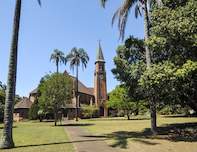Area of Importance
Greytown was initially an important area in the history of KwaZulu-Natal. The town was founded in the 1850s and named after the governor of the Cape Colony, Sir George Edward Grey. Interestingly enough, the country’s first prime minister, Louis Botha, was born on a farm near the town in 1862.

During the 1860s, white settlers created a community centred around religion. A Dutch Reformed Church was built in 1861 to summon local farmers to worship. A Town Hall was built, and oppressive measures were put in place to control the other inhabitants of the area, the Zulus. A struggle for a democracy then ensued in the town with the Bambatha Rebellion. This rebellion was an uprising against the reigning white authority by a local Zulu chief, and they forced the white community into the town hall to give up their power in 1897.
Other historic buildings include Greytown’s Mosque, built in 1946. It replaced the original mosque that was built in 1898. The Shri Vishnu Mandir Temple is also a point of interest, as well as the St James Anglican Church.
The area around Greytown is known to host Bushman paintings, and back in the day, the Zulu tribe created a cairn of stones where the road drops into Weenen, and they would pass it for good luck and blessings.